The Power of Internal Links for SEO
|
Click play to LISTEN to the article below
|

Internal links may seem simple; however, they are an incredibly powerful tool for improving your website’s SEO. By effectively using links between pages on your site, you can enhance user experience, help search engines better understand your content, and distribute “link equity” to pages you want to rank higher.
What Are Internal Links?: A hyperlink that connects two pages within the same domain is an internal link. For example, if you have a blog post that links to your “About” page or product category pages, those are internal links. They allow users to naturally navigate through your site.
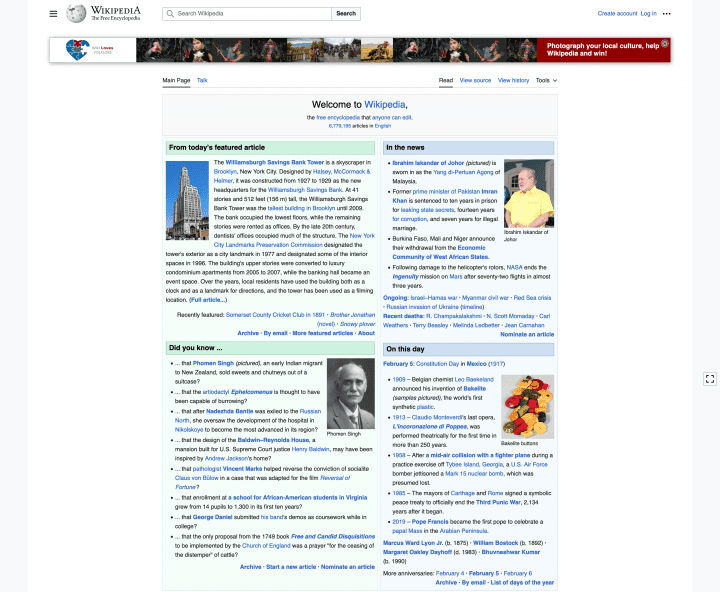
Benefits of Internal Links
Here are some of the major benefits of using internal links as part of your SEO strategy:
- Improves Crawlability: Internal links create a pathway for search engine crawlers to fully explore your site. By linking pages together, you ensure search engines can find and index all of your content. This helps maximize your pages’ chances of ranking.
- Enhances User Experience: Well-structured links allow visitors to easily navigate and find related content on your site. This improves engagement and time-on-site. Happy users equal better SEO!
- Distributes Equity: Internal links pass “link equity” between pages. Additionally, linking to a lower-ranking page from a higher-ranking page gives the lower-ranking page a boost. This allows you to strategically elevate target pages.
- Provides Context: Descriptive anchor text within these links gives search engines insight into how pages relate. This can improve relevance and rankings for keyword-focused content.
Let’s take a look at several case studies illustrating these benefits!
Case Studies
Uproer
In this case study from Uproer, sharing how their client, IFTTT, drove 33% Y/Y organic traffic growth by making internal linking a priority.
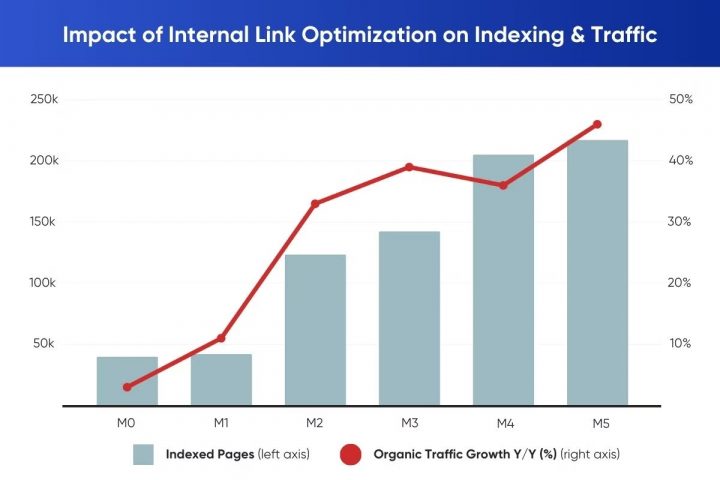
Here are several tactics pursued with IFTTT:
- Moving JavaScript internal links to server-side
- HTML Sitemaps
- Redesign pages to include internal links
- Combine content plan with internal linking strategy
- Remove nofollow from important internal links
Extrapolate out the performance of your pages that are indexed (and, perhaps, have at least some crawlable internal links). Model out a few scenarios that illustrate the value to be gained given improvements to indexing.
Hypothetical: If we improve our indexing rate from 60% to 80%, we can expect a 15% lift in traffic which equates to $350,000 in annual conversion value.
Get Back to Basics with an HTML Sitemap
An HTML sitemap is typically a super feasible ask from a development perspective and can be an incredibly effective internal link asset.
The launch of IFTTT’s HTML sitemap delivered nearly a 3x increase in indexed pages in the span of two weeks.
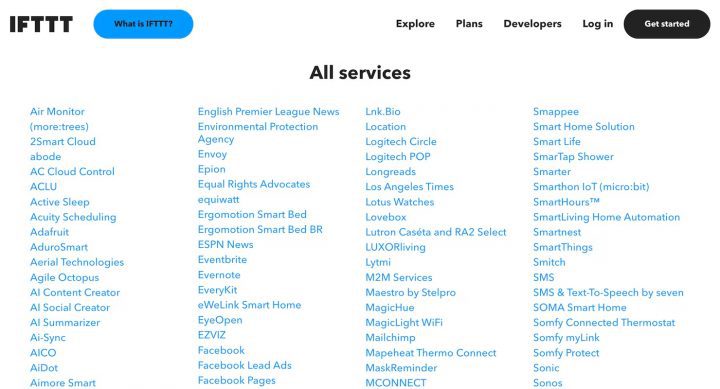
Pursue a Content Plan that Prioritizes Internal Linking
Building internal links should be an ongoing SEO strategy, not just a one-time activity.
- Internal links help get content discovered and indexed by search engines by creating pathways for crawlers.
- They build topical authority on a site by connecting relevant pages around key subjects.
- Internal links improve keyword rankings by signaling importance between semantically related content.
- Regular internal linking helps search bots efficiently crawl and classify new content.
- High SEO potential pages should be prioritized for internal link building to maximize search performance.
While we can’t pretend to present a complete internal linking strategy based on these studies, the data does hint at some possible best practices and optimizations.
ZyppySEO
This study looked at 23 million internal links across 1,800 websites, representing approximately 520,000 individual URLs. This data was then compared to that from Google Search Console to determine search clicks for each URL.
Results
- More internal links are associated with higher traffic, but only to a point.
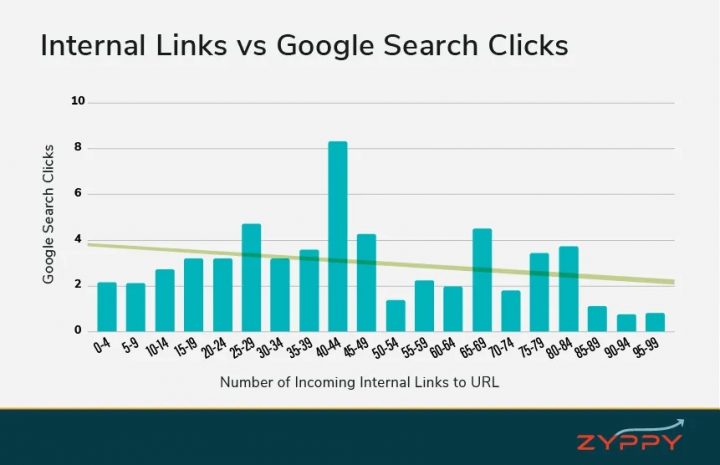
- Sitewide/navigation links seem to have a powerful effect, mostly on larger, high-authority sites. The effectiveness is less clear on small, lower-authority sites.
- Anchor text variety is highly correlated with higher search traffic.
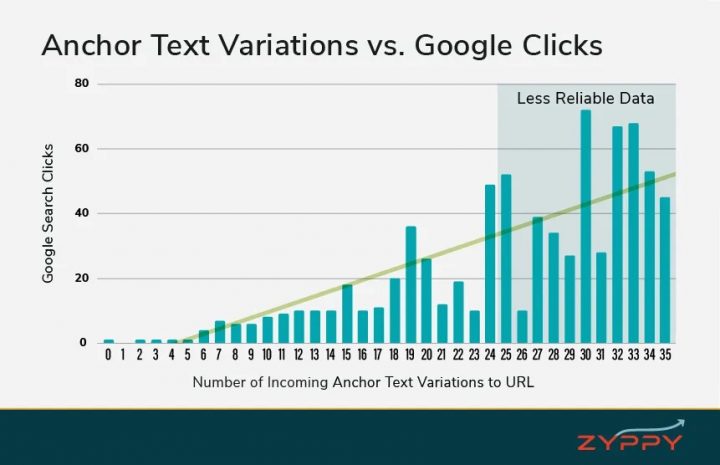
- Naked URL anchors (links without anchor text, but just the url itself) don’t seem to hurt and, in fact, are associated with more traffic.
- At least some exact match anchors are associated with significantly higher traffic.
Seer Interactive
The Internal Linking Test
Observation: Internal links can have a positive impact on keyword rankings.
Research: I found some information from doing a few searches, but nothing that made me feel completely confident that this MIGHT work.
Hypothesis #1: By adding internal links from various pages to key pages (product pages in this case) we can improve conversion rates, increase transactions and revenue, and lower the percentage of visitors not visiting a product page.
Hypothesis #2: If I can find 3 to 5 opportunities to internally link to a page with the exact same anchor text, rankings would improve by 1 to 3 positions (which would be a big win for the queries I was targeting and the difference between page 1 and page 2 of SERPS).
Client 1 (Hypothesis 1 test): Surfaced over 80 internal linking opportunities targeting to increasing internal links to product pages/product category pages within two hours. This didn’t require anything from our client except for the action of logging into their CMS and applying the link we provided to their existing content (no content changes were made).
Client 2 (Hypothesis 2 test): Surfaced over 30 internal linking opportunities to increase internal links to 10 different pages with 10 different anchor texts. This didn’t require anything from our client except for the action of logging into their CMS and applying the link we provided to their existing content (no content changes were made).
Results
Hypothesis 1 Results: This one is probably not surprising, but my hypothesis was correct. By adding 80+ internal links from various pages (FAQs, blogs, etc) and comparing two weeks pre- implementations vs. two weeks post-implementation we saw:
- +192% increase in CVR (conversion rate)
- +76% increase in transactions
- +116% increase in revenue
- +23% increase in page views to Product pages
- Lowered percentage of visitors not viewing product pages by 58%
All stats above are Organic-channel specific
Hypothesis 2 Results: Somewhat to my surprise, this hypothesis was also correct! By adding internal links with the same anchor text and comparing two weeks pre- implementations vs, two weeks post-implementation we saw:
- Keyword rankings improve by an average of 2.5 positions (anchor text are the keywords that were tracked)
- CVR (conversion rate) of pages that were being linked to improved by +7.5%
- Transactions on pages that were being linked to improved by +13%
All stats above are Organic-channel specific
Make internal linking a proactive tactic in your content strategy and you’ll realize SEO gains more quickly and efficiently!
Take a look our SEO features page learn more about how to use the OHT platform’s SEO features to learn more about optimizing your internal linking strategy!
References
- ← Introducing Our-Hometown’s Author Profiles: Boost SEO & Trust
- Turn Archives into Assets: Unleash Website Engagement with Historical Features →

Recent Comments